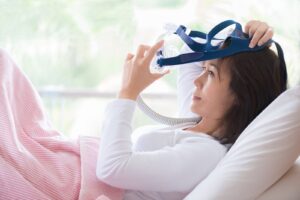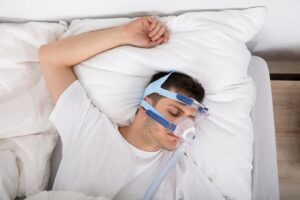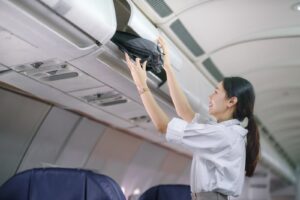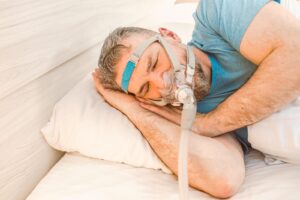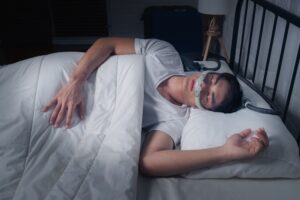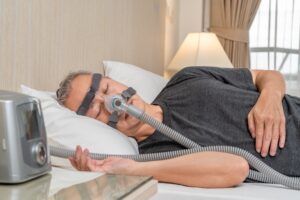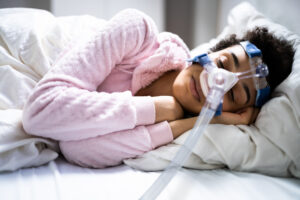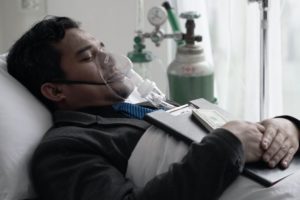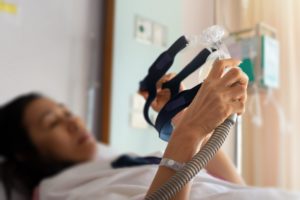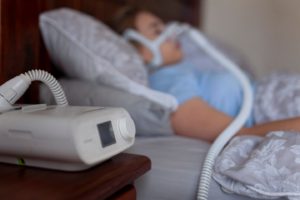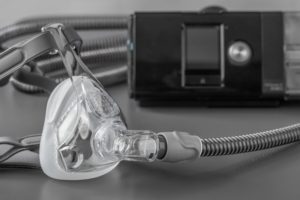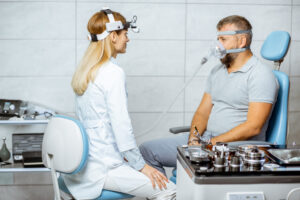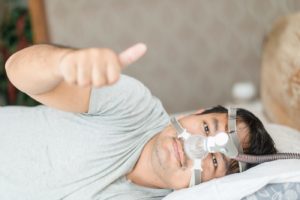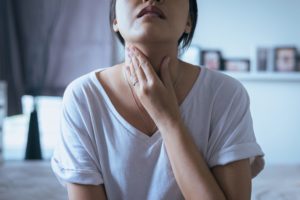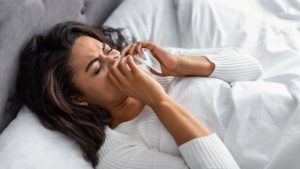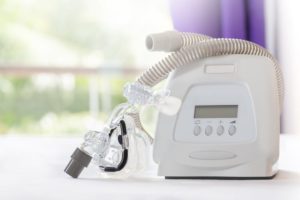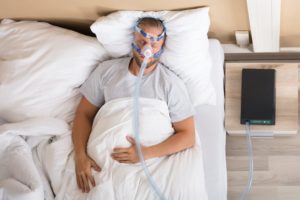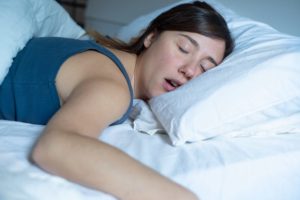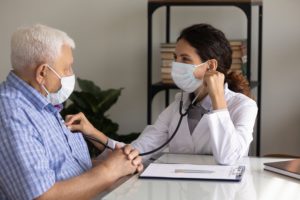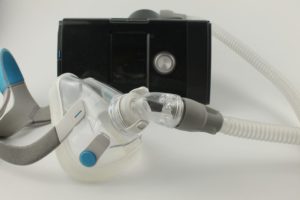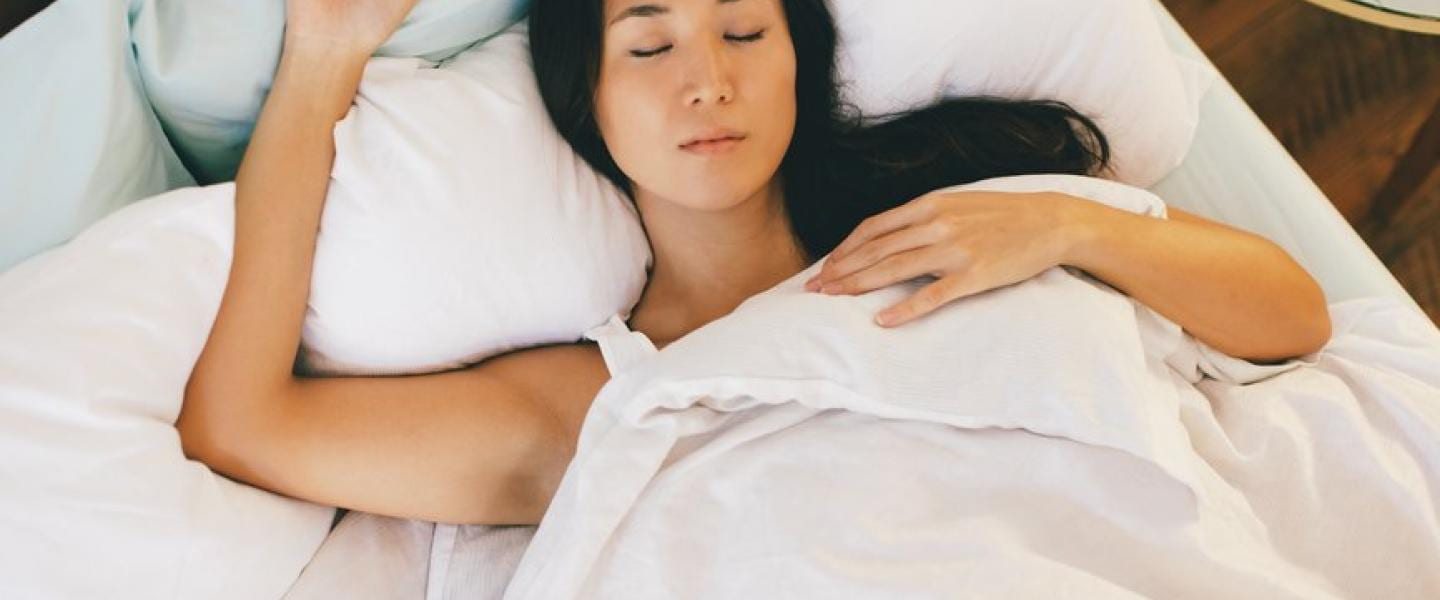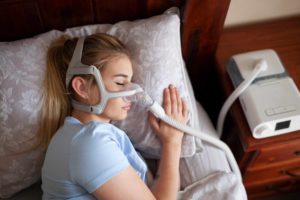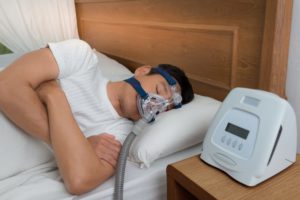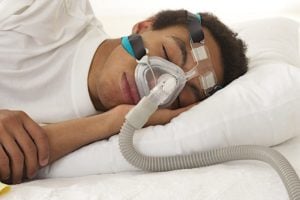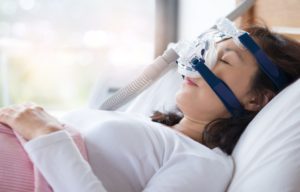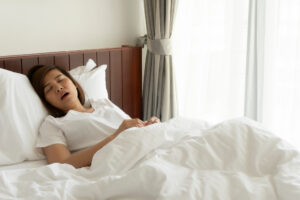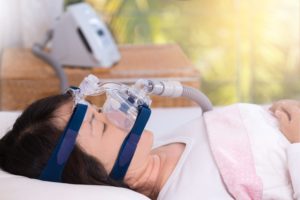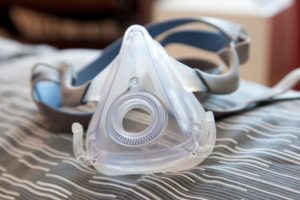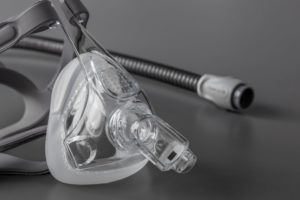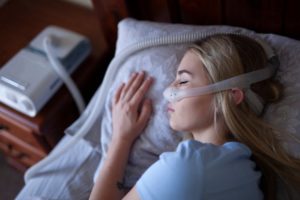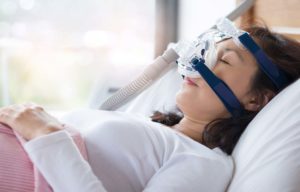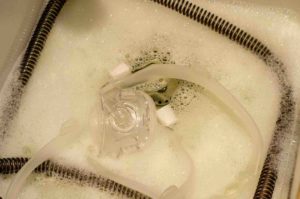How Does a CPAP Machine Work?
- A CPAP machine works by drawing in air from the room, filters out any particles, and pressurizes it to the prescribed level. When CPAP users breathe in the pressurized air, it gently stents open the relaxed tissue and muscles to hold space for normal breathing.
- CPAP machines pressurize air to a single prescribed level, although some offer features that slowly increase the air pressure while you fall asleep, or lower it slightly when you breathe out.
- The parts of a CPAP machine include a power cord or battery, a motor to draw in air, a filter to remove dust, allergens, and debris from the air, and a humidifier to add moisture and warmth to the air.
Starting CPAP therapy can be confusing and overwhelming for many people, but the process is easier when you understand how your CPAP machine works. Continuous positive airway pressure (CPAP) therapy is a form of positive airway pressure (PAP) therapy, which treats obstructive sleep apnea (OSA) and other breathing disorders by using pressurized air to keep your airways open while you sleep.
Below, we’ll walk you through the science behind CPAP therapy, then take a closer look at CPAP equipment and accessories, CPAP functions, and alternative treatments for sleep apnea.
What Is a CPAP Machine?
A CPAP machine is a device that draws in air from the room, pressurizes it, and delivers it to you via tubing and a mask. CPAP machines pressurize air to a single prescribed level, although some offer features that slowly increase the air pressure while you fall asleep, or lower it slightly when you breathe out. These features are designed to improve your comfort rather than to affect your treatment.
Modern CPAP machines are quiet, and most are small enough to fit on your bedside table alongside a clock and a lamp. Even smaller CPAP machines, which are designed for use while traveling, are also available.
Other PAP Devices
Some PAP devices are similar to CPAP machines, while others function quite differently.
- Auto-adjusting positive airway pressure (APAP): Instead of using a single programmed air pressure level, APAP machines are programmed with a prescribed pressure range. The machine monitors your breathing and adjusts the pressure up or down using an internal algorithm. Modern PAP machines meant for treating mild to moderate sleep apnea are capable of both CPAP and AutoPAP.
- Bilevel positive airway pressure (BPAP): BPAP machines use a higher air pressure level when you inhale, then switch to a lower level when you exhale.
Suspect You May Have Sleep Apnea?
Answer three questions to understand if you should be concerned.
Why Would You Use a CPAP Machine?
Untreated OSA is associated with a wide range of both short and long-term symptoms, ranging from mood changes and headaches to a higher risk of heart disease and stroke . CPAP therapy is considered the gold standard for treating OSA , and the benefits of CPAP include:
- Better quality of sleep
- More energy
- Significantly less snoring (or none at all)
- Lower blood pressure
- Improved concentration and memory
- Lower risk of stroke and heart disease
- Less depression and anxiety
- Improved insulin sensitivity
There’s also evidence that long-term CPAP use has a beneficial effect on obesity and heart rhythm problems , both of which are associated with OSA.
The biggest problem with CPAP therapy is that many people choose not to use their CPAP machine because they’re unable to acclimate to treatment, discomfort with the mask or air pressure, or intolerant for another reason . There are many reasons for not using your CPAP machine, but there are also many ways to address any issues you may be having. Your doctor can work with you to find an approach to CPAP therapy that meets your needs and ensures that using your machine is comfortable and effective.
How Does a CPAP Machine Work?
When people with OSA sleep, the tissue and muscles in their throat become relaxed and can fully or partially block their airway. This obstruction causes people with OSA to stop breathing for short periods, which are known as apnea events .
PAP therapy, including CPAP therapy, uses pressurized air to keep the airway open in much the same way that wind keeps a windsock open. Doctors use a test called a PAP titration study (or or treatment sleep study) to determine the minimum air pressure level required to keep the user’s airway clear under different conditions, such as different body positions or sleep stages. This level is then prescribed and programmed into the CPAP machine.
The CPAP machine draws in air from the room, filters out any particles, and pressurizes it to the prescribed level. The air is also humidified to increase comfort with the treatment. When CPAP users breathe in the pressurized air, it gently stents open the relaxed tissue and muscles to hold space for normal breathing. With their airway unobstructed, users can inhale normally. When the user breathes out, the exhaled air escapes through one-way vents or valves in their mask.
What Are the Parts of a CPAP Machine?
Although CPAP machines represent medical equipment with multiple parts, their underlying structure is relatively easy to understand. A CPAP machine includes:
- A power cord or battery
- A motor to draw in air from the room
- A filter to remove dust, allergens, and debris from the air
- A humidifier to add moisture and warmth to the air so that it is more comfortable to breathe
What Other CPAP Equipment Is Necessary?
To use a CPAP machine, you must also purchase equipment such as:
- Standard or heated tubing to send the pressurized air from the machine to your mask
- A CPAP mask that seals to the nose or around both the nose and the mouth to conduct the air
There are multiple types of CPAP masks, each with its own benefits and drawbacks. With masks that conduct the pressurized air through the nose only, it’s important that your mouth stay closed while you’re asleep. Although the exact design of a mask can vary significantly between manufacturers, the major CPAP mask types are:
- Nasal masks, which seal around your nose
- Nasal pillow masks, which inflate to seal inside your nostrils
- Nasal cradle masks, which seal at the base of your nose
- Full face masks, which seal around your nose and mouth
- Oronasal or hybrid masks, which seal around the mouth and up to the base of the nose
No CPAP mask style is inherently better or worse than the others, and your doctor can help you choose a CPAP mask that fits your unique needs and preferences.
“The mask is arguably the most important part of the therapy to get right, since it’s the part that touches you,” says sleep medicine physician and CPAP expert Audrey Wells, MD. “Similar to finding the right jeans, bra, or shoes, it’s important to go through some trial and error to find out what style and size of CPAP mask works best. CPAP masks that conduct air through the nose are usually associated with greater comfort and longer CPAP use.”
What CPAP Accessories Are Available?
CPAP accessories can make your CPAP equipment more comfortable to use, easier to maintain, or simpler to travel with. Some of the most popular optional CPAP accessories include:
- CPAP pillows that are designed to leave space for your mask
- Mask liners or pads to reduce skin irritation and air leaks
- Chin straps and mouth tape to discourage breathing through your mouth while asleep
- Cleaning supplies such as wipes, soap, and specialized brushes
- External power sources such as batteries
- Travel bags to protect and organize your equipment

What Are a CPAP Machine’s Functions?
Many modern CPAP machines offer advanced features and integrated technology to improve your PAP therapy experience.
- Ramp settings: Ramp settings begin at a lower air pressure level and slowly increase the pressure until they reach your prescribed level, making it easier to fall asleep. Most CPAP machines with ramp settings allow you to choose the timing to match how long it usually takes you to fall asleep.
- Pressure relief: CPAP machines with pressure relief settings lower the air pressure level when you exhale. Some people find that this feature makes breathing feel more natural, making for a much more comfortable experience.
- Data collection: CPAP machines usually gather data about how you use the machine, as well as recording apnea events, pressure levels, leaks, and more. This information is used by your doctor to monitor your PAP therapy and is often required by insurance providers as a condition of coverage. Secure digital (SD) cards used to be the most common method of collection, but wireless data transfer is now more common.
- App integration: Many manufacturers offer smartphone apps that can access the data collected by your CPAP machine. Although CPAP apps differ between manufacturers, most provide support, guidance, and daily reports about your sleep health. While new users may benefit the most from the tips and coaching, even experienced CPAP users are likely to appreciate the additional insight provided by the sleep health reports.
How Does CPAP Compare to Other Sleep Apnea Treatments?
Although PAP therapy is the leading treatment for OSA, other forms of treatment include lifestyle changes, oral devices, and surgery. If you’re curious about any of these treatment options, your doctor can answer your questions and help you discover whether they may be right for you.
- Lifestyle changes: While your doctor is unlikely to prescribe lifestyle changes as the only treatment for OSA, losing weight (with or without medication) and reducing alcohol consumption have been shown to help reduce OSA symptoms and their severity.
- Changing how you sleep: Sleeping on your back, also known as the supine position, can increase the risk of apnea events . If you find yourself rolling onto your back while asleep, there are devices that can help you stay on your side. This intervention is effective if your sleep apnea only occurs when you’re sleeping supine and you tolerate being on your side throughout the night.
- Mandibular advancement devices: Mandibular advancement devices pull your jaw forward, which helps prevent the area behind your tongue from collapsing during sleep . While these devices are not right for everyone, they can be a comfortable long-term CPAP alternative for some people .
- Myofunctional therapy: Myofunctional therapy strengthens and trains the muscles in your lips, tongue, mouth, and throat. This process, when done correctly, can help reduce the severity of OSA and promote nasal breathing. This is usually viewed as one of the layers of sleep apnea treatment and not as a monotherapy . Devices that use electrical stimulation to aid in myofunctional therapy may also be helpful .
- Surgery: There are several types of surgery designed to treat OSA, including the removal of tonsils or throat tissue, the repositioning of the jaw, and the insertion of an electrical stimulator device. Surgery is not always successful in controlling OSA, but it can be beneficial for some people who do not tolerate PAP therapy [/ocm_reference).

Still have questions? Ask our community!
Join our Sleep Care Community — a trusted hub of sleep health professionals, product specialists, and people just like you. Whether you need expert sleep advice for your insomnia or you’re searching for the perfect mattress, we’ve got you covered. Get personalized guidance from the experts who know sleep best.
References
17 Sources
-
MedlinePlus: National Library of Medicine (US). (2023, January 9). Obstructive sleep apnea – adults
https://medlineplus.gov/ency/article/000811.htm -
Calik M. W. (2016). Treatments for obstructive sleep apnea. Journal of Clinical Outcomes Management, 23(4), 181–192.
https://pubmed.ncbi.nlm.nih.gov/27134515/ -
Lin HJ, Yeh JH, Hsieh MT, Hsu CY. Continuous positive airway pressure with good adherence can reduce risk of stroke in patients with moderate to severe obstructive sleep apnea: An updated systematic review and meta-analysis. Sleep Med Rev. 2020;54:101354. doi:10.1016/j.smrv.2020.101354
https://pubmed.ncbi.nlm.nih.gov/32755811/ -
Jean-Louis G, Brown CD, Zizi F, et al. Cardiovascular disease risk reduction with sleep apnea treatment. Expert Rev Cardiovasc Ther. 2010;8(7):995-1005. doi:10.1586/erc.10.55
https://pubmed.ncbi.nlm.nih.gov/20602560/ -
Velescu DR, Marc M, Manolescu D, Trăilă D, Oancea C. CPAP Therapy on Depressive and Anxiety Symptoms in Patients with Moderate to Severe Obstructive Sleep Apnea Syndrome. Medicina (Kaunas). 2022;58(10):1402. Published 2022 Oct 6. doi:10.3390/medicina58101402
https://pubmed.ncbi.nlm.nih.gov/36295563/ -
Iftikhar IH, Khan MF, Das A, Magalang UJ. Meta-analysis: continuous positive airway pressure improves insulin resistance in patients with sleep apnea without diabetes [published correction appears in Ann Am Thorac Soc. 2013 Jun;10(3):279]. Ann Am Thorac Soc. 2013;10(2):115-120. doi:10.1513/AnnalsATS.201209-081OC
-
Pleava R, Mihaicuta S, Serban CL, et al. Long-Term Effects of Continuous Positive Airway Pressure (CPAP) Therapy on Obesity and Cardiovascular Comorbidities in Patients with Obstructive Sleep Apnea and Resistant Hypertension-An Observational Study. J Clin Med. 2020;9(9):2802. Published 2020 Aug 30. doi:10.3390/jcm9092802
-
Weaver TE, Grunstein RR. Adherence to continuous positive airway pressure therapy: the challenge to effective treatment. Proc Am Thorac Soc. 2008;5(2):173-178. doi:10.1513/pats.200708-119MG
https://pubmed.ncbi.nlm.nih.gov/18250209/ -
Faber J, Faber C, Faber AP. Obstructive sleep apnea in adults. Dental Press J Orthod. 2019;24(3):99-109. Published 2019 Aug 1. doi:10.1590/2177-6709.24.3.099-109.sar
https://pmc.ncbi.nlm.nih.gov/articles/PMC6677338/ -
St-Onge MP, Tasali E. Weight Loss Is Integral to Obstructive Sleep Apnea Management. Ten-Year Follow-up in Sleep AHEAD. Am J Respir Crit Care Med. 2021;203(2):161-162. doi:10.1164/rccm.202007-2906ED
https://pubmed.ncbi.nlm.nih.gov/32795248/ -
Simou, E., Britton, J., & Leonardi-Bee, J. (2018). Alcohol and the risk of sleep apnoea: A systematic review and meta-analysis. Sleep Medicine, 42, 38–46.
https://pubmed.ncbi.nlm.nih.gov/29458744/ -
Joosten, S. A., O’Driscoll, D. M., Berger, P. J., & Hamilton, G. S. (2014). Supine position related obstructive sleep apnea in adults: Pathogenesis and treatment. Sleep Medicine Reviews, 18(1), 7–17.
https://pubmed.ncbi.nlm.nih.gov/23669094/ -
Serra-Torres S, Bellot-Arcís C, Montiel-Company JM, Marco-Algarra J, Almerich-Silla JM. Effectiveness of mandibular advancement appliances in treating obstructive sleep apnea syndrome: A systematic review. Laryngoscope. 2016;126(2):507-514. doi:10.1002/lary.25505
https://pubmed.ncbi.nlm.nih.gov/26228493/ -
Vecchierini MF, Attali V, Collet JM, et al. Mandibular advancement device use in obstructive sleep apnea: ORCADES study 5-year follow-up data. J Clin Sleep Med. 2021;17(8):1695-1705. doi:10.5664/jcsm.9308
https://pubmed.ncbi.nlm.nih.gov/34165074/ -
Camacho, Macario et al. “Myofunctional Therapy to Treat Obstructive Sleep Apnea: A Systematic Review and Meta-analysis.” Sleep vol. 38,5 669-75. 1 May. 2015, doi:10.5665/sleep.4652.
https://www.ncbi.nlm.nih.gov/pmc/articles/PMC4402674/ -
Nokes B, Baptista PM, de Apodaca PMR, et al. Transoral awake state neuromuscular electrical stimulation therapy for mild obstructive sleep apnea. Sleep Breath. 2023;27(2):527-534. doi:10.1007/s11325-022-02644-9
https://pubmed.ncbi.nlm.nih.gov/35624401/ -
Carvalho, B., Hsia, J., & Capasso, R. (2012). Surgical therapy of obstructive sleep apnea: A review. Neurotherapeutics, 9(4), 710–716.
https://pubmed.ncbi.nlm.nih.gov/22915293/


